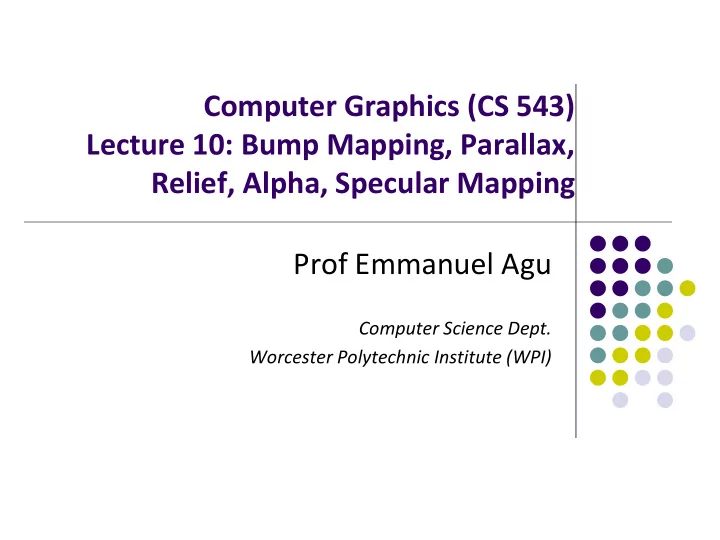

Computer Graphics (CS 543) Lecture 10: Bump Mapping, Parallax, Relief, Alpha, Specular Mapping Prof Emmanuel Agu Computer Science Dept. Worcester Polytechnic Institute (WPI)
Bump Mapping
Bump mapping: examples
Bump mapping by Blinn in 1978 Inexpensive way of simulating wrinkles and bumps on geometry Too expensive to model these geometrically Instead let a texture modify the normal at each pixel, and then use this normal to compute lighting = + geometry Bump mapped geometry Bump map Use normals of bumpy geometry Stores heights: can derive normals
Bump mapping: Blinn’s method Idea: Distort the surface normal at point to be rendered Option a: Modify normal n along u, v axes to give n’ In texture map, store how much to perturb n (b u and b v ) Using bumpmap Look up b u and b v n ’ = n + b u T + b v B (T and B are tangent and bi-tangent vectors) Note: N’ is not normalized Bump map code similar to normal map code. Just compute, use n’ instead of n
Bump mapping: Blinn’s method Option b: Store values of u, v as a heightfield Slope of consecutive columns determines how much changes n along u Slope of consecutive rows determines how much changes n along v Option c (Angel textbook): Encode using differential equations
Bump Mapping Vs Normal Mapping Bump mapping Normal mapping (Normals n =( n x , n y , n z ) stored as Coordinates of normal (relative to local distortion of face orientation . tangent space) are encoded in Same bump map can be color channels tiled/repeated and reused for Normals stored combines many faces) face orientation + plus distortion. )
Displacement Mapping Uses a map to displace the surface at each position Offsets the position per pixel or per vertex Offsetting per vertex is easy in vertex shader Offsetting per pixel is architecturally hard
Parallax Mapping Bump and normal maps increase surface detail, but do not simulate: Parallax effects: Slanting of texture with view angle Blockage of one part of surface by another part Parallax mapping simulates parallax effects Looks up a texture location offset depending on view angle Different texture returned after offset Parallax map Normal map Looks up here Looks up here
Relief (or Parallax Occlusion) Mapping Parallax mapping approximates parallax Sometimes doesn’t work well for occlusion effects Implement a heightfield raytracer in a shader, detect blockage Pretty expensive, but looks amazing
Relief Mapping Example Cool YouTube Video: https://youtu.be/EkLKhsRzE-g
Light Mapping
Light Maps Good shadows are complicated and expensive If light and object positions do not change, shadows do not change Can “bake” the shadows into a texture map as a preprocess step During lighting, lightmap values are multiplied into resulting pixel Apply this in fragment shader
Specular Mapping Store specular in a map Use greyscale texture to store specular component
Alpha Mapping RGBA: A or alpha is how transparent material is 0 transparent, 1 opaque Represent the alpha channel with a texture Can give complex outlines, used for plants RGB Alpha Render Bush Render Bush on polygon rotated on 1 polygon 90 degrees
Alpha Mapping Rotation trick works at eye level (left image) Breaks down from above (right image)
Mesh Parametrization
Mesh Parametrization
Parametrization in Practice Texture creation and parametrization is an art form Option: Unfold the surface
Parametrization in Practice Option: Create a Texture Atlas Break large mesh into smaller pieces
References Interactive Computer Graphics (6 th edition), Angel and Shreiner Computer Graphics using OpenGL (3 rd edition), Hill and Kelley Real Time Rendering by Akenine-Moller, Haines and Hoffman
Recommend
More recommend